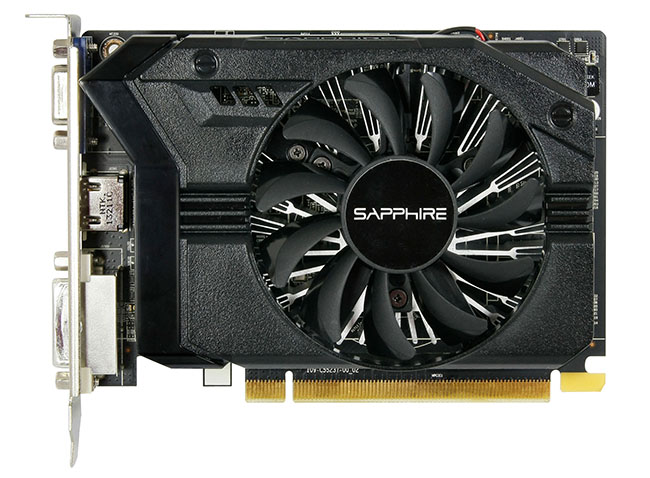AMD Radeon R7 250 examined
AMD introduced a number of GPUs during October of last year. The press focussed on the R9 280X, R9 270X and R7 260X, which are, for the most part, rebrands of existing Radeon HD 7000-series technology. Slipping under the radar somewhat, AMD brought a couple of all-new GPUs to market in the form of the modestly-priced Radeon R7 250 and R7 240.
These GCN-toting, mainstream cards, starting at £50, are based on what is known as the 'Oland' die - one that is purpose-built for these models. Measuring 90mm² and sipping on a maximum 65W, thus not requiring an external power connector, you won't find it anywhere else in AMD's past or present GPU stack.
Specifications
| GPU | Radeon R7 250 2GB | Radeon R7 240 | Radeon HD 7730 | Radeon R7 IGP | Radeon R7 260X 2GB |
|---|---|---|---|---|---|
| Launch date | October 2013 | October 2013 | April 2013 | January 2014 | October 2013 |
| DX API | 11.2 | 11.1 | 11.2 | 11.1 | 11.2 |
| Process (nm) | 28 | 28 | 28 | 28 | 28 |
| Transistors (million) | 1,040 | 1,040 | 1,500 | NA | 2,080 |
| Approx Die Size (mm²) | 90 | 90 | 123 | NA | 160 |
| Processors | 384 | 320 | 384 | 512 | 896 |
| Texture Units | 24 | 20 | 24 | 32 | 56 |
| ROP Units | 8 | 8 | 8 | 8 | 16 |
| Peak GPU Clock/Boost (MHz) | 1,050 | 780 | 800 | 720 | 1,100 |
| GFLOPS | 806.4 | 499.2 | 614.4 | 737.3 | 1,971 |
| Memory Clock (MHz) | 1,800 DDR3 4,600 GDDR5 |
1,800 DDR3 4,500 GDDR5 |
4,500 | 2,133 (system RAM) | 6,400 |
| Memory Bus (bits) | 128 | 128 | 128 | 128 | 128 |
| Max bandwidth (GB/s) | 28.8 DDR3 73.6 GDDR5 |
28.8 DDR3 72 GDDR5 |
72 | 34.1 | 102.4 |
| TDP (watts) | 65 | 30 | 47 | NA | 115 |
| Power Connectors | None | None | None | NA | 6-pin |
| Current price ($) | 89 | 69 | 80 | NA | 139 |
Analysis
The Radeon R7 250 is the premium implementation of Oland, and the 384:24:8 configuration is almost identical to the Radeon HD 7730. AMD bolsters the R7 250's potential by clocking it in at 1,000MHz, rising to 1,050MHz under Boost, compared to 800MHz for the HD 7730.
But potential buyers need to be wary of the memory speed - there are two versions of this GPU that use DDR3 and GDDR5, respectively. The impact of chosen memory has a huge effect on performance, with the GDDR5 model far more preferable as it provides more than double the bandwidth.
It's actually worthwhile to compare the R7 250 against the also-GCN IGP used in the A10-7850K. The APU can team a discrete card up with the IGP for extra performance by way of Dual Graphics. The two processors' specifications are broadly similar, albeit with the IGP taking its memory-bandwidth allocation from system memory rather than onboard RAM. For folk considering running Dual Graphics the DDR3 version makes more sense as the memory bandwidth is similar to the IGP's.
Sapphire's card
Sapphire has a trio of Radeon R7 250 cards in its arsenal. A passively-cooled version runs with 800MHz core and 4,500MHz (GDDR5) memory while a fan-assisted model cranks up the core to a potential 1,050MHz and memory to 4,600MHz. Note that both cards ship with a 1GB framebuffer.
Outfitted with the same cooler but housed on an even-smaller PCB measuring under six inches is the card in for review today. This little GPU matches the other card's 1,050MHz peak speed and doubles the framebuffer to 2GB. Sounds great, right? Trouble is, increasing the framebuffer comes at the direct expense of memory frequency; it's clocked in at just 1,800MHz. 2GBs of onboard memory doesn't make much sense on a card of this ilk, either, as the GPU doesn't have the visceral muscle to make best use of it.
And there's little in it with respect to price: the 2GB model retails for around £62 while the faster-clocked 1GB offering is available for £65. But hey, at least Sapphire offers consumers the choice, and larger-memory cards often play well in emerging markets.
The frugal power consumption means there's no auxillary six-pin power connector required here. It's worth knowing the cooler protrudes such that this is a 1.5-slot card and therefore may not be suitable for itty-bitty systems that are spatially restricted.
Outputs are sensible, comprising of VGA, HDMI and single-link DVI. The latter is an important consideration if you're buying this card for productivity purposes; the DVI connection cannot run the lovely 2,560x1,440-pixel monitors - we use one to test with - at their native resolution. This problem, if we can call it that, goes away when used in modern AMD APU system; the onboard graphics support dual-link DVI.











